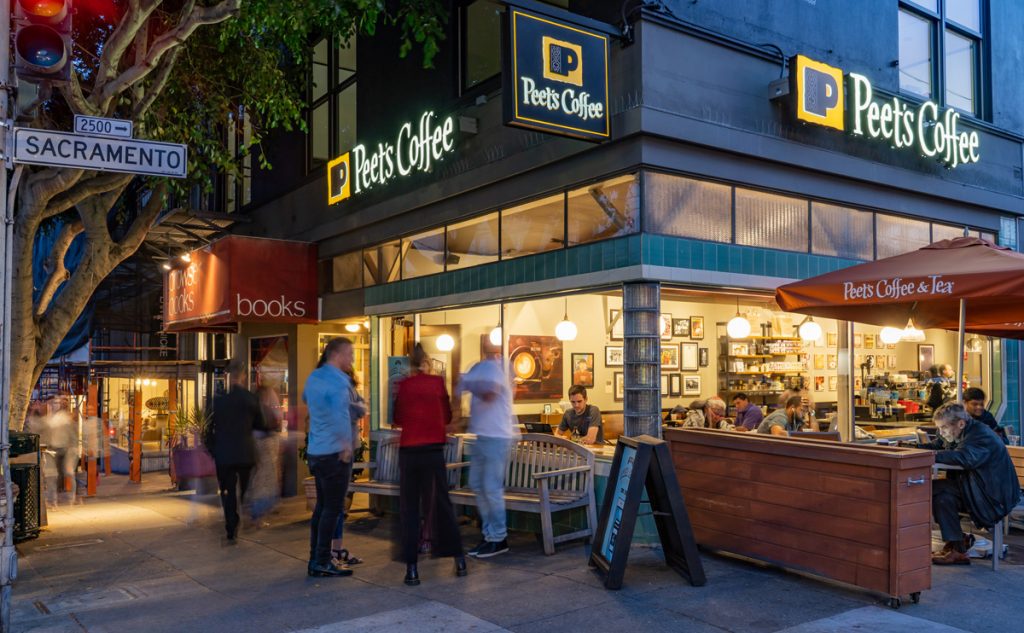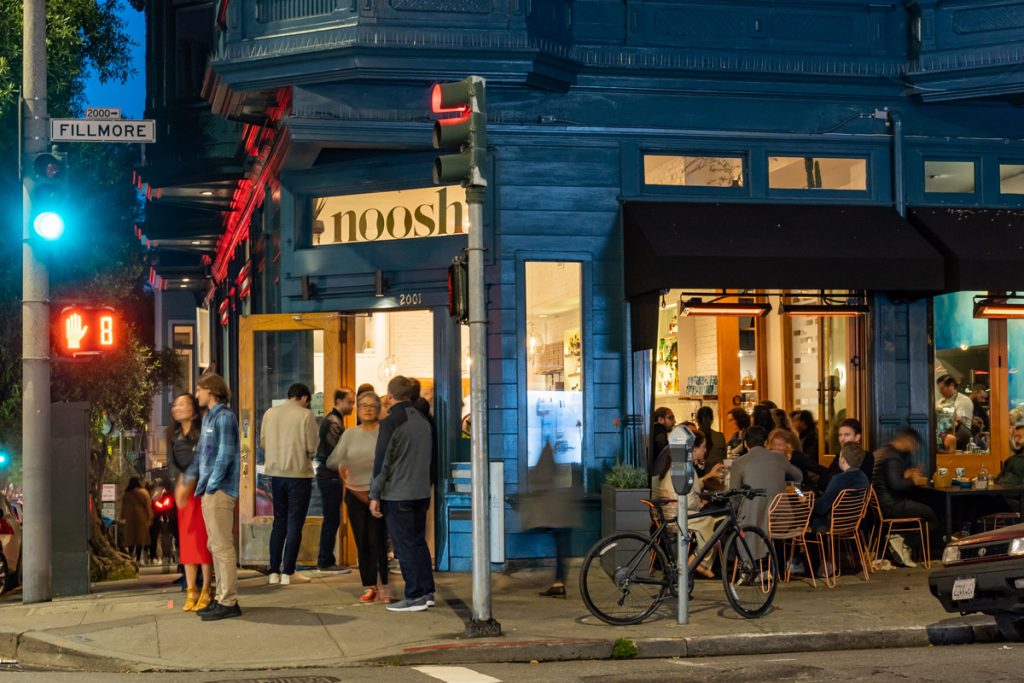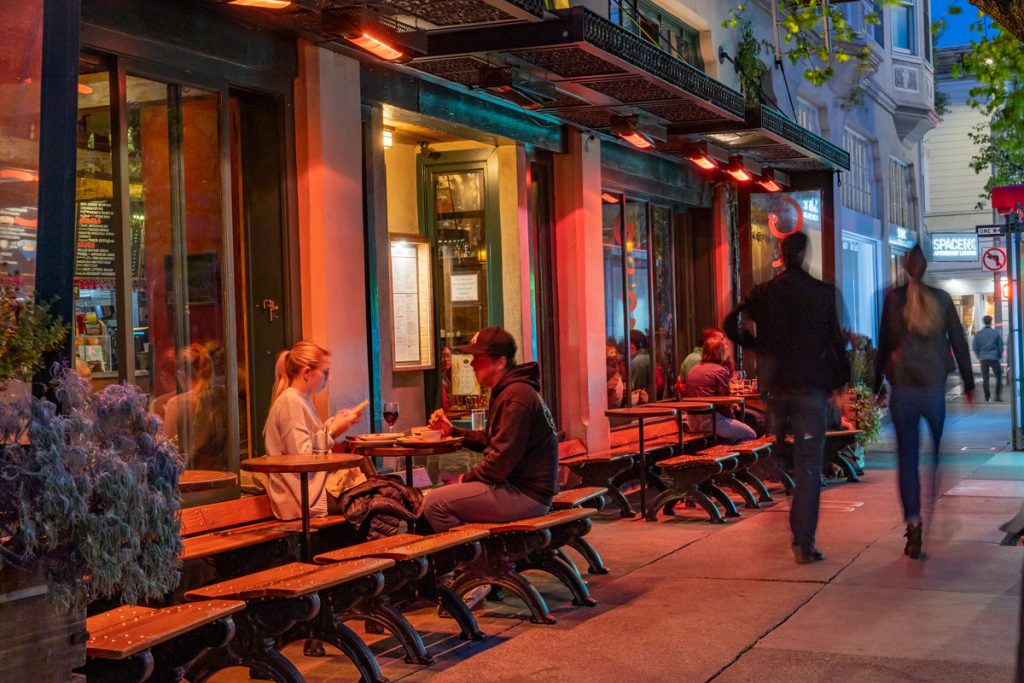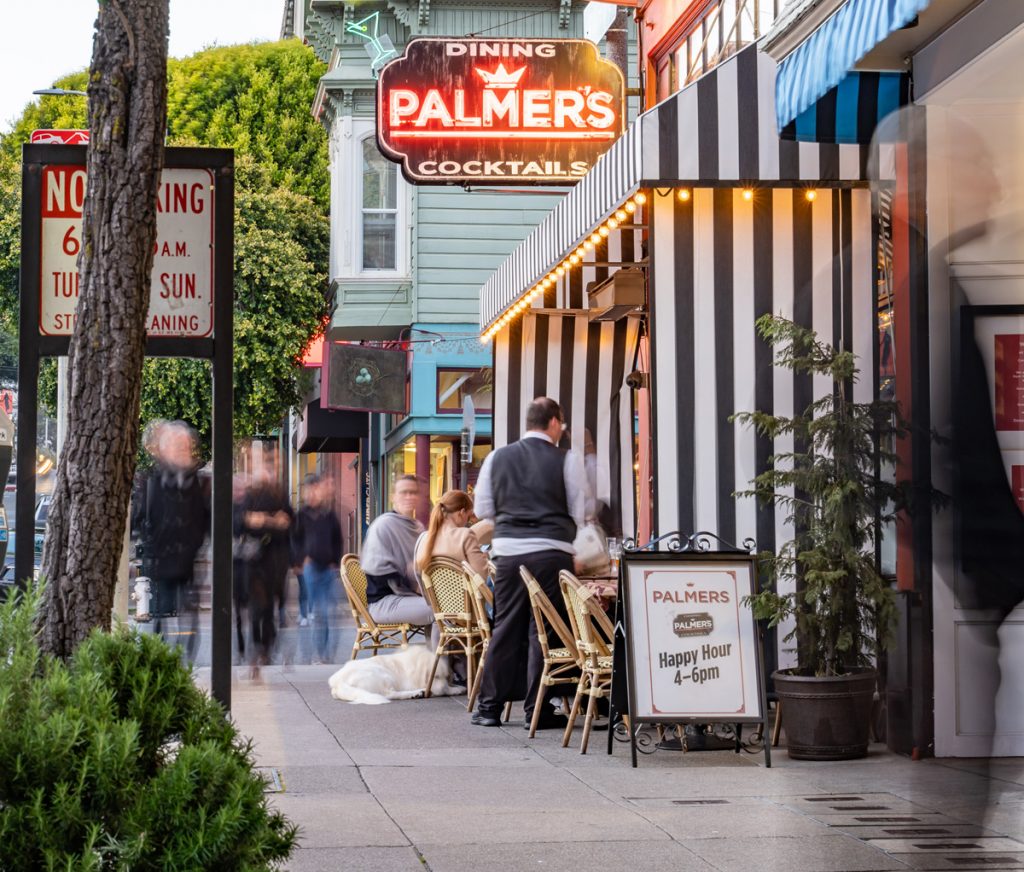By SUSAN SWARD
Up and down Fillmore, sidewalk spots keep springing up.
Noosh, the new restaurant at Pine and Fillmore, has three four-tops outside with heat lamps at the ready. Blue Bottle Coffee finally has its outside tables back at Fillmore and Jackson. The Snug, at Clay and Fillmore, is considering putting in for a permit. And established sunny sidewalk terraces at Chouquet’s, at Washington, and Harry’s and The Grove, between Pine and California, host a crush of people, often with baby carriages and dogs along for the party.
Slowly, since 1993, when they were first blessed by the city, sidewalk tables and chairs have proliferated. Now there are more than 450 permitted sites citywide — with 19 alone on Fillmore Street. Chestnut Street has 19 as well, Columbus Avenue has 21 and Clement Street has 10. All across the city, people gather outside, chatting, hanging out, drinking and eating. Streets that once felt cold and dead bustle with activity and life, particularly on the days when sunshine blesses San Francisco.
It was not ever thus. This San Francisco explosion has its local roots in a meeting at the now-closed Cafe Puccini in North Beach in 1993. Angela Alioto, then president of the Board of Supervisors, gathered together a powerful group of citizens, including poet and City Lights Booksellers co-founder Lawrence Ferlinghetti, filmmaker Francis Ford Coppola and Alioto’s father, former San Francisco Mayor Joe Alioto. Urged on by Graziano Lucchesi, owner of Cafe Puccini, and other North Beach merchants, her goal was to build a coalition behind a city regulation allowing cafes and restaurants to have sidewalk seating.
Alioto got the attendees to sign what she christened “the Puccini petition” — it hangs today on her law office wall — and she introduced a measure to the Board of Supervisors to make it happen.
“Ferlinghetti and Coppola came to the hearing at City Hall,’’ she recalls. “It was boisterous. It was like a reunion of old North Beach businesses — like old home week. The hearing was on Ash Wednesday, and a lot of the bakers brought hot cross buns. But in North Beach people can be loud, and they hate change. We had to get over the organized opposition from people who were saying it would impede the sidewalk and be an attractive nuisance.”
Today, she says, some of the same people who fought the regulation thank her for the change it has wrought in the city.
Under the regulation, applicants submit a drawing of their proposed seating along with other required details. Minimum clearance for passing pedestrians is six feet. Most permits cost between $1,000 and $1,500 a year, says Jennifer Blot, the Public Works Department’s deputy director of communications.
But the change has not been without its ruts in the road.
“I understand the city’s position — it has a lot on its hands — but the city inspectors should have a little bit of fluidity,’’ says Levon Der Bedrossian, owner of La Mediterranee, which last month celebrated its 40th anniversary at 2210 Fillmore. Der Bedrossian has found himself having to defend to the city the precise way he positions his chairs on the street in front of his restaurant. “Ultimately, it is a partnership between the city, the merchants and the citizens. We want to respect the rules, but at the same time I think the city can be more efficient with its communication and consideration.”
He adds: “We are more than happy to pay our taxes. We love this city.”
At Florio, on Fillmore between Pine and Bush, general manager John Castanon found the permit procedure for sidewalk seating fairly complicated. “But the benefit to businesses with outdoor sidewalk seating is obvious,” he says. “Say you average $50 a person, so that’s $50 times eight people you didn’t have before as customers. You just expanded your dining room — so it is definitely worth it.’’
San Francisco’s embrace of sidewalk seating can be seen as part of a larger trend in the way cities worldwide are approaching their urban landscapes in a bid to make them more habitable.
One of the most celebrated examples is the change created in New York City in a number of bustling locations, including Times Square. Behind much of that change was San Francisco-born Janette Sadik-Kahn, a lawyer who served as the commissioner of the New York City Department of Transportation from 2007 to 2013 under Mayor Michael Bloomberg.
In her book Street Fight: Handbook for an Urban Revolution, co-authored with Seth Solomonow, Sadik-Kahn described the first time she saw Times Square in her role as transportation commissioner. Almost 90 percent of the space belonged to cars, while 82 per cent of people were passing through on foot. Primarily by redesigning the traffic flow, the city gained two and a half acres of public space.
Marcus Owens, a landscape architect who lectures at the University of California Berkeley, also sees sidewalk seating on Fillmore Street and elsewhere as part of the movement worldwide to bring warmth and vitality to urban landscapes.
“The idea is to make streets for the people — make them more liveable and walkable,’’ Owens says. “If you enliven a space, it can be a means to improve the public realm. But over the years San Francisco has a history of problems with its streets.’’ He notes that the great American landscape architect Frederick Law Olmstead suggested that Van Ness Avenue be a grand boulevard, “but the city hasn’t been able to pull it off.’’
San Francisco has, though, been on the forefront, Owens says, of cities installing parklets — small seating areas or green spaces along a sidewalk. There are already 66 parklets in San Francisco, including the Fillmore Stoop in front of Delfina Pizzeria on California Street.
Sidewalk seating was a bit slower in developing.
“In fact, we were late coming to this concept,’’ says Dean Macris, the city’s former planning director. “Everyone thinks of Paris, but the major cities around the world are doing this. We don’t have wide sidewalks here, so you could argue it’s a bit of a nuisance. But it makes the city more exciting,” he says. “It is just more fun to walk around, looking at the people sitting at tables, eating and talking. It makes streets more friendly and enjoyable.”
Albert Rainer, owner of Palmer’s Tavern at Clay and Fillmore, is a proponent of adding more sidewalk seating in the neighborhood and throughout the city. “For one thing, there’s the safety issue. More eyeballs out on the street, the less the bad boys think they can get away with something,” he says. “And people enjoy sitting out there. It creates a neighborhood atmosphere, a sense of community.’’
Filed under: Food, Drink & Lodging








